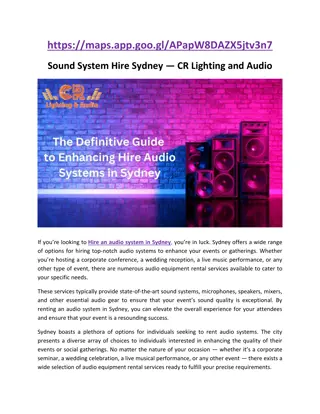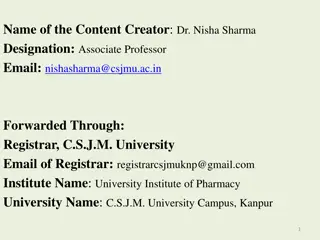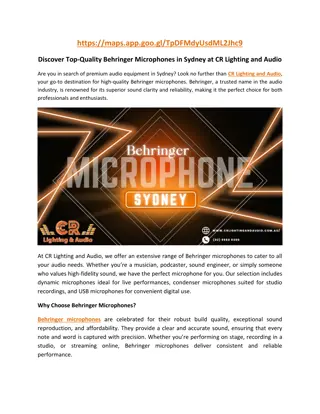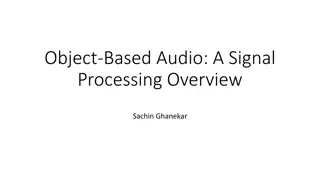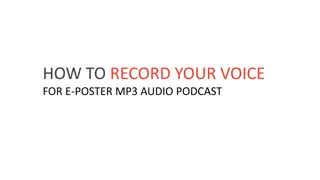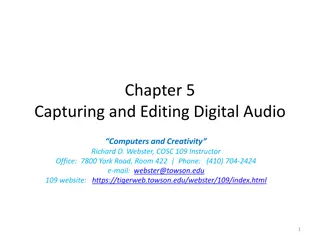Essential Maintenance and Quality Control of Audio Systems and Equipment
Explore the world of audio maintenance and quality control led by Engr. Sadeeq Omeiza Musa. Learn to identify and troubleshoot technical faults seamlessly, ensuring smooth operations. Discover the evolution from analogue to digital broadcast productions and the rise of Internet Protocol TV (IPTV). Dive into audio terminologies, innovations in audio networking, basics of audio production, and more. Enhance your skills to maintain audio systems effectively and stay updated with industry trends.
Download Presentation

Please find below an Image/Link to download the presentation.
The content on the website is provided AS IS for your information and personal use only. It may not be sold, licensed, or shared on other websites without obtaining consent from the author. Download presentation by click this link. If you encounter any issues during the download, it is possible that the publisher has removed the file from their server.
E N D
Presentation Transcript
MAINTENANCE OF AUDIO SYSTEMS /EQUIPMENT AND QUALITY CONTROL BY Engr Sadeeq Omeiza Musa GM -ITS
Training Goals & Objectives At the end of the training, participants should be able to: Identify any Technical Fault when it arises and proactively arrest such without interrupting normal operations. Maintain Audio Systems and Equipment
OUTLINE Preambles Introduction to Audio Terminologies The Future & Innovations in Audio for Broadcast- Audio over IP( Audio Networking)
Broadcast Productions has come a long way. It involves Production and Transmission of Audio and Video Content. The ongoing Digitization process which involves Migration from Analogue to Digital, whereby pictures and sounds can be significantly transmitted at higher quality within the same spectrum that analogue TV occupies
The Current trend is Internet Protocol TV(IPTV), Online TV Production and Streaming. Contents can be viewed over the Internet. Broadcast equipment are now designed to meet this standard. This makes for fast, reliable and flexible broadcasting. This aims for Higher Production Quality and Increased viewership.
INTRODUCTION TO AUDIO Audio means "of sound" or "of the reproduction of sound". An Audio signal is an Electrical representation of sound. It is the audible content in a media Production. Specifically, it refers to the range of frequencies detectable by the human ear approximately 20Hz to 20kHz.
BASICS OF AUDIO PRODUCTION Microphones Mixing consoles Monitoring Recorders
ANALOGUE AUDIO Analogue audio signals are voltages which are proportional to the pressures in the original sound waves. Sound begins as a physical wave form and transformed into electrical representation of the wave form via a transducer(Microphone).
ANALOGUE AUDIO Disadvantages Analogue audio signals characteristics remain the same in spite of storage , transformation, duplication and amplification. Major disadvantage: They are susceptible to distortions.
DIGITAL AUDIO The digital audio refers to technology that records, stores and reproduces sound by encoding an audio signal indigital form. Digital Audio isuseful in recording,manipulation, mass production and distribution of sound. Digital audio system starts with ADC.
SDI (EMBEDDED AUDIO) Both the HD and SD serial interfaces provide for 16 channels of embedded audio. (8 pairs) at 48 kHz, 24-bit audio channels along with the video (super imposed /modulated). PCM audio is stored, in a manner directly compatible with the AES3 digital audio interface .
DIGITAL AUDIO ADVANTAGES Benefits of Digital Audio include : Reduces noise Reduced Distortions Convenience of Storage Transmission Retrieval Reduces Distortions,
QUALITIES OF GOOD AUDIO Distraction-Free: hearing clearly, without yanking her attention toward some random anomaly Intelligible: i.e to be understandable Natural: needs to sound realistic Consistency : plays a big role in all three of metrics above. This s achieved using Mixer controls, Metering and Monitoring
GENERATING AUDIO SIGNALS Audio can be generated in a controlled environment such as studio(with acoustics) and from an uncontrolled environment(with ambient). The kind of environment determines the kind of microphone to be used.
GENERATING AUDIO SIGNALS Audio signals can be generated Via two means.Termed signal level or intensity. Audio can be generated in a controlled environment such as studio(with acoustics) and from an uncontrolled environment(with ambient).The kind of environment determines the kind of microphone to be used.
GENERATING AUDIO SIGNALS Audio signals exists in two forms Termed signal level or intensity : Mic Level Signals(Mic Level Voltage :60 dBV (0.001 volt) to -40 dBV (0.010 volt).The electrical current generated by a microphone is very small measured in millivolts. Before it can be used for anything serious the signal needs to be amplified
GENERATING AUDIO SIGNALS Mic Level Signals(Mic Level Voltage :60 dBV (0.001 volt) to -40 dBV (0.010 volt).The electrical current generated by a microphone is very small measured in millivolts. Before it can be used for anything serious the signal needs to be amplified
GENERATING AUDIO SIGNALS Microphone sensitivities range- From -60 dBu to -22 dBu Referenced to 94 dB Sound Pressure Level(SPL). Sound quality of a microphone is a function of its: Audio quality, Sensitivity, Directionality(Polar Pattern) and Physical appearance.
COMMON AUDIO CHALLENGES AND POSSIBLE SOLUTIONS -No matter how well you plan ahead, sooner or later you will probably run into an audio related problem. -To help you out in those situations, I ve listed some of the more common problems encountered in doing audio- for-video, along with some possible solutions.
BUZZ, HUM, CRACKLE, AND OTHER NOISES -These are almost always caused by an electrical problem somewhere in the system. -A low, steady buzz or intermittent crackle usually indicates a loose ground wire, probably in or near a connector. -A humming sound is usually picked up by unbalanced cables near light fixtures, dimmer switches, or power cables. -You can try moving the mic cable around a bit, but the only permanent solution is to use balanced microphone cables. -The use of HUM BUGER to eliminate hum in audio can also be employed.
DISTORTION -This fuzziness or general lack of clarity results when the input of some piece of equipment in your audio chain is being overloaded (a condition called clipping ). -Once the signal is distorted, there is absolutely no way to remove the distortion with another device further down the audio chain. -If the signal level coming from the microphone is too high for the camera or recorded and sounds distorted, for example, you must turn down that channel s input level control on the camera or recorded in very loud situations, the range of adjustment might not be wide enough; you can use an attenuator (also called a pad), which reduces the level of the signal by a specified amount without altering its sound. -The amount of attenuation is measured in decibels, or dB for short. A 10 dB or 20 dB attenuator is frequently all that is required to make a signal easier for the mixer to deal with; a 50 Db attenuator will bring a line-level signal all the way down to mic level
INSIDE A BARREL SOUND -This usually results when the microphone is located too far from the talker. -The more reverberant the room is, the closer the microphone must be in order to obtain good sound quality. - Inside a barrel sound can also be caused by phase cancellation, which occurs when the same sound waves reach more than one microphone at slightly different times. -When the signals are combined in the mixer or during editing, the time delay between them causes unpredictable changes to the signal, resulting in a strange sound. The easiest way to avoid this problem is turn down unneeded microphones or other sound sources.
POPPINGAND WIND NOISE -Popping is caused by an explosive sound wave striking the microphone diaphragm, such as that which occurs when a talker says words beginning with the letters p or t . -To lessen the likelihood of this phenomenon occurring, you should: -keep the microphone at least 6 inches away from the talker s mouth, tilted toward the user at about 45 degrees from vertical, and use a foam windscreen if the microphone s built-in pop filter is insufficient or if a very close source-to- mic distance is required. Wind noise is frequently a problem outdoors, especially with condenser microphones. -The only solution is to use a foam windscreen, and in extreme conditions, a zeppelin or blimp type windscreen such as those used on shotgun microphones.
FEEDBACK If you are using microphones to feed a loudspeaker system in the same room, you may occasionally encounter feedback (a loud howl or squeal when microphones are moved too close to the loudspeakers.) - Feedback is usually caused by a combination of several factors such a speaker volume, placement of mics and loudspeakers, and room acoustics. *What can you do about feedback? .Move the microphone closer to the desired sound source Use directional microphones (cardioid, supercardioid, etc.) Reduce the number of open microphones Try to keep microphones and loudspeakers as far away from each other as possible. Acoustically treat the room (if possible) to eliminate hard, reflective surfaces such as glass, marble, and wood . However, the manipulation of the auxilliaries inputs and outputs of the audio console can be use to eliminate or reduce feedback.
AUDIO AND VIDEO OUT OF SYNC -Most of these problems are caused when audio and video signals pass through two different paths and having a difference in the processing time between the two. -The audio could either be lagging or leading the video. - If the sync problem is as a result of poor editing , it is usually very hard to correct , unless the clip is disbanded and the audio adjusted. -One way to fix audio sync is to pass the both signal through and embedder, so that both signals pass same way rather than going into a separate interface. -Secondly, audio sync delay can be introduced to fix the audio sync problems. -Audio sync delays is usually set in milliseconds, the amount of delay needed to add to the audio signal. -This can be achieved while watching someone speaking and adjusting the control and stop when it looks like the audio and video are in sync





